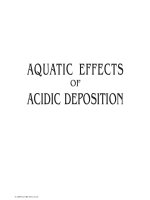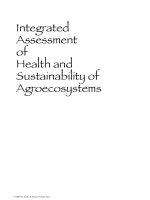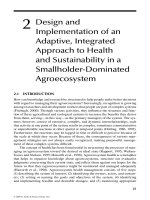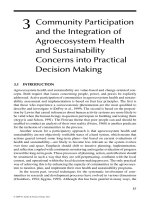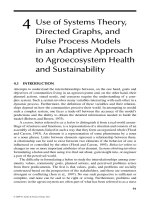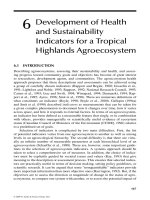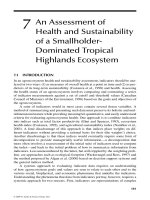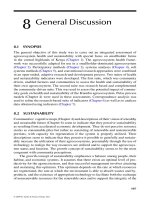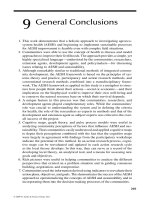Integrated Assessment of Health and Sustainability of Agroecosystems - Chapter 1 pptx
Bạn đang xem bản rút gọn của tài liệu. Xem và tải ngay bản đầy đủ của tài liệu tại đây (1.24 MB, 42 trang )
Integrated
Assessment
of
Health and
Sustainability of
Agroecosystems
© 2009 by Taylor & Francis Group, LLC
Advances in Agroecology
Series Editor: Clive A. Edwards
Agroecosystems in a Changing Climate
Paul C.D. Newton, R. Andrew Carran, Grant R. Edwards, and Pascal A. Niklaus
Agroecosystem Sustainability: Developing Practical Strategies
Stephen R. Gliessman
Agroforestry in Sustainable Agricultural Systems
Louise E. Buck, James P. Lassoie, and Erick C.M. Fernandes
Biodiversity in Agroecosystems
Wanda Williams Collins and Calvin O. Qualset
Interactions Between Agroecosystems and Rural Communities
Cornelia Flora
Landscape Ecology in Agroecosystems Management
Lech Ryszkowski
Multi-Scale Integrated Analysis of Agroecosystems
Mario Giampietro
Soil Ecology in Sustainable Agricultural Systems
Lijbert Brussaard and Ronald Ferrera-Cerrato
Soil Organic Matter in Sustainable Agriculture
Fred Magdoff and Ray R. Weil
Soil Tillage in Agroecosystems
Adel El Titi
Structure and Function in Agroecosystem Design and Management
Masae Shiyomi and Hiroshi Koizumi
Tropical Agroecosystems
John H. Vandermeer
Advisory Board
Editor-in-Chief
Clive A. Edwards
The Ohio State University, Columbus, OH
Editorial Board
Miguel Altieri, University of California, Berkeley, CA
Lijbert Brussaard, Agricultural University, Wageningen, The Netherlands
David Coleman, University of Georgia, Athens, GA
D.A. Crossley, Jr., University of Georgia, Athens, GA
Adel El-Titi, Stuttgart, Germany
Charles A. Francis, University of Nebraska, Lincoln, NE
Stephen R. Gliessman, University of California, Santa Cruz, CA
Thurman Grove, North Carolina State University, Raleigh, NC
Maurizio Paoletti, University of Padova, Padova, Italy
David Pimentel, Cornell University, Ithaca, NY
Masae Shiyomi, Ibaraki University, Mito, Japan
Sir Colin R.W. Spedding, Berkshire, England
Moham K. Wali, The Ohio State University, Columbus, OH
© 2009 by Taylor & Francis Group, LLC
CRC Press is an imprint of the
Taylor & Francis Group, an informa business
Boca Raton London New York
Integrated
Assessment
of
Health and
Sustainability of
Agroecosystems
Thomas Gitau
Margaret W. Gitau
David Waltner-Toews
© 2009 by Taylor & Francis Group, LLC
CRC Press
Taylor & Francis Group
6000 Broken Sound Parkway NW, Suite 300
Boca Raton, FL 33487-2742
© 2009 by Taylor & Francis Group, LLC
CRC Press is an imprint of Taylor & Francis Group, an Informa business
No claim to original U.S. Government works
Printed in the United States of America on acid-free paper
10 9 8 7 6 5 4 3 2 1
International Standard Book Number-13: 978-1-4200-7277-8 (Hardcover)
This book contains information obtained from authentic and highly regarded sources. Reasonable
efforts have been made to publish reliable data and information, but the author and publisher can-
not assume responsibility for the validity of all materials or the consequences of their use. The
authors and publishers have attempted to trace the copyright holders of all material reproduced
in this publication and apologize to copyright holders if permission to publish in this form has not
been obtained. If any copyright material has not been acknowledged please write and let us know so
we may rectify in any future reprint.
Except as permitted under U.S. Copyright Law, no part of this book may be reprinted, reproduced,
transmitted, or utilized in any form by any electronic, mechanical, or other means, now known or
hereafter invented, including photocopying, microfilming, and recording, or in any information
storage or retrieval system, without written permission from the publishers.
For permission to photocopy or use material electronically from this work, please access www.copy-
right.com ( or contact the Copyright Clearance Center, Inc. (CCC), 222
Rosewood Drive, Danvers, MA 01923, 978-750-8400. CCC is a not-for-profit organization that pro-
vides licenses and registration for a variety of users. For organizations that have been granted a
photocopy license by the CCC, a separate system of payment has been arranged.
Trademark Notice: Product or corporate names may be trademarks or registered trademarks, and
are used only for identification and explanation without intent to infringe.
Library of Congress Cataloging-in-Publication Data
Library of Congress Cataloging-in-Publication Data
Gitau, Thomas.
Integrated assessment of health and sustainability of agroecosystems / Thomas
Gitau, Margaret W. Gitau, David Waltner-Toews.
p. cm. (Advances in agroecology)
Includes bibliographical references and index.
ISBN 978-1-4200-7277-8 (hardback : alk. paper)
1. Agricultural ecology. 2. Sustainable agriculture. 3. Agroforestry.
4. Agrobiodiversity. 5. Soil ecology. 6. Tillage. I. Gitau, Margaret W. II.
Waltner-Toews, David, 1948- III. Title. IV. Series.
S589.7.G48 2008
630 dc22 2008013094
Visit the Taylor & Francis Web site at
and the CRC Press Web site at
T&F_LOC_A_Master.indd 1 4/7/08 9:06:58 AM
© 2009 by Taylor & Francis Group, LLC
To all those who made Thomas
Gitau’s work possible, and to those
who supported him and his family
as he took his final journey.
© 2009 by Taylor & Francis Group, LLC
vii
Foreword
This welcome volume on agricultural sustainability is the twelfth in the series
addressing ‘Advances in Agroecology’ that has been published by CRC Press since
1997. It is authored by two innovative scientists both well-known in their elds,
Dr. Margaret W. Gitau of Florida A&M University and Professor David Waltner-
Toews of the University of Guelph, Canada. The research described in the book is
based on the work of Thomas Gitau, who led a study in the ecological sustainability
and impacts on human health of tropical highland agroecosystems in Kenya. His
premature death at the age of 38 in 2005 was a great loss to the scientic commu-
nity and particularly to the International Development Research Centre that funded
his work. Fortunately, his work was almost complete and the publication of this
volume was made possible by the efforts of Dr. Margaret Gitau, Dr. Thomas Gitau’s
widow, who was very much involved in his research, and Professor Waltner-Toews,
who was a partner in the research.
The book is unique in providing links between human health and well-being
issues and agroecosystem ecological sustainability, and draws on both management
theory and practice, as well as participatory action research and ecologically-based
complex systems theories. The work addresses problems that are crucial to many
rapidly changing and urbanizing tropical environments. It represents an in-depth
case study of a tropical agroecosystem that produced results and that has global
ramications in relation to sustainability.
Many of the tools used by Dr. Gitau were developed from other elds and incor-
porated in more innovative ways than work reported in many comparative books.
It is clearly written and provides a great deal of practical information as well as
addressing theoretical and systems issues in depth.
Clive A. Edwards
Professor of Entomology and Environmental Science
Soil Ecology Laboratory
The Ohio State University
© 2009 by Taylor & Francis Group, LLC
ix
Preface
About the same time as the work described by Thomas Gitau in this volume was
being designed, the Ecosystem Approaches to Human Health Programme Initiative
(also known as the Ecohealth Programme) of Canada’s International Development
Research Centre (IDRC) was exploring health and environment research as an eco-
and socially systemic set of reective actions to produce sustainable changes in the
health of human populations. Working with colleagues at the International Livestock
Research Institute (Nairobi) and the Universities of Guelph and Nairobi, Gitau pro-
posed an exciting mix of qualitative participatory action and systemic thinking to
address agroecosystem health issues in the Kenyan Highlands. The work intrigued
IDRC with its innovative use of qualitative participatory approaches in a formal,
systemic, assessment framework drawn from environmental and health risk assess-
ments. IDRC was also very interested in the integration of development activities
into research processes since the prevailing approach to development at the time
was to separate intervention from research. Such an approach often seemed to lead
to lost opportunities for learning on the one hand and to ill-conceived interventions
on the other.
At the time, applying the concept of health to ecosystems was controversial. The
value-laden nature of health was felt by some to detract from objective observation
and modeling of ecosystem phenomena and to be unscientic. There were concerns
that ecosystem health was anthropomorphic or at least anthropocentric, and that it
would distract researchers and policymakers alike from the urgent necessity of eco-
logical conservation. Yet, the concept of ecosystem health held traction with decision
makers and appealed to a broader audience than the ideas of resilience and integ-
rity favored by many ecologists. Some forward-thinking ecological thinkers, such as
Allen and Hoekstra (1991), began to argue that people and their processes were part
of ecosystems, and that the problems of ecological sustainability were of a scale and
complexity that required not only multidisciplinary scientic approaches but also
increasing participation of civil society.
Meanwhile, theoreticians such as James Kay, David Waltner-Toews, and David
Rapport were building on the work of Henry Regier and others to develop a systemic
framework for applying ecosystem health. Community and decision maker participa-
tion, interventions, and monitoring were integrated into the research process. To these
researchers, the health metaphor facilitated the integration of human dimensions into eco-
logical thinking, an element they felt was crucial to making meaningful progress toward
changing how people relate to environment to improve ecological sustainability.
Thomas Gitau’s research was among the earliest to apply ecosystem health concepts
in an African rural development context. His work was instrumental in demonstrat-
ing the feasibility of fully participatory action-oriented research meant to understand
the dynamics of an agricultural ecosystem. He and his collaborators formalized the
collaborative and participatory characterization of the agroecosystem and the identi-
cation of indicators with scholarly applications of systems theory, social and political
© 2009 by Taylor & Francis Group, LLC
x Preface
sciences, and ecology. He had a unique way of adapting methods from other disci-
plines, such as ecology, when no techniques were apparent within the discipline at
hand for answering important questions. He was both rigorous and open-minded.
At IDRC, community-based natural resource management thinking was evolv-
ing to consider how more sustainable natural resources management could lead to
better human health and well-being. IDRC Ecohealth Programme Initiative staff
found the health paradigm to be easily understood and conceptually exible in initial
diagnoses of health problems with environmental drivers. Thomas Gitau’s systems
descriptions became known as “ecosystem mapping,” a tool now widely advocated
by IDRC’s Ecohealth Programme ofcers in the development of new projects. The
participation of civil society, government, and business stakeholders in the diagno-
sis of environment and health problems and in the design and implementation of
interventions based on strong research ndings is a central tenet of the Ecohealth
Programme. Many subsequent applications of approaches similar to Thomas Gitau’s
have shown that actions to establish a healthier community must be community led
to achieve meaningful and lasting impact.
Challenges identied by Thomas are still relevant today. There are methodologi-
cal difculties to transdisciplinary approaches. There are political impediments to
the empowerment of disadvantaged and sometimes marginalized groups. Technical
methods for holistic data analysis are still imperfect. Many current IDRC projects
still grapple with some or all of these, and yet progress is still made.
Today, there is the learned International Society for Ecology and Health and an
academic journal called EcoHealth. There are communities of practice contributing
both theoretically and empirically to the evolution of the approach. Perhaps most
telling are the increasing number of concrete examples of positive changes in the
world as a result of ecosystem health thinking; ecological and social improvements
in several downtown Kathmandu wards where animals had been slaughtered (a proj-
ect that had begun as an attack on a simple disease problem [hydatid disease]) grew
into a decade-long series of resilient local organizational, environmental, and health
changes (e.g., Waltner-Toews et al., 2005). Many of the techniques used had been
developed by Gitau in Kenya. Similarly, work on linking child health and natural
resource use in the Peruvian Amazon drew strongly on Gitau’s work (Murray et al.,
2002; Murray, 2000). In Mexico’s manganese mining districts, ecohealth approaches
have successfully been applied to dene a health problem, raise community and
local government awareness, and pursue the translation of research ndings into
policy changes to protect human health (Montes et al., 2008; Riojas-Rodriguez et al.,
2006). In Malawi, researchers working closely with the community helped introduce
soyabean to the cropping system, with ensuing substantial impacts on child nutrition.
The project used ecohealth approaches to develop locally appropriate uses for the
beans while exploring a variety of social factors inuencing child nutrition (Bezner
Kerr et al., 2007). IDRC today continues to develop and apply systemic and inte-
grated action research on environment and health problems using transdisciplinary
multistakeholder approaches with attention to gender and social equity.
Much of the theoretical and practical work that Gitau’s thinking inuenced and
interacted with has also been summarized and synthesized in two books. Ecosys-
tem Sustainability and Health: A Practical Approach (David Waltner-Toews, 2004,
© 2009 by Taylor & Francis Group, LLC
Preface xi
Cambridge University Press) is built around the development of the Adaptive Meth-
odology for Ecosystem Sustainability and Health, to which Gitau’s work was a major
contributor. The Ecosystem Approach: Complexity, Uncertainty, and Managing for
Sustainability (edited by David Waltner-Toews, James Kay, and Nina-Marie Lister,
Columbia University Press, 2008) includes essays by colleagues working in Nepal,
India, Peru, New Zealand, various sites in Africa, and North and South America, as
well as a chapter by Gitau and his co-worker.
The reader of this book will learn much about the practical realities of implement-
ing participatory, multistakeholder, transdisciplinary ecosystem health research. The
book presents tools and approaches that can be applied in many rural development
research projects today. And, the reader will certainly benet from Thomas Gitau’s
qualities as a researcher and a convener. Thomas Gitau was a pioneer whose sci-
entically rigorous and conceptually innovative research in Kiambu contributed to
the early development of ecosystem health thinking. Having briey known Thomas
while we were both graduate students, I can also say that he was a kind and generous
soul whose untimely death robbed us not only of his scientic potential but also of
the pleasure of his congenial company.
RefeRences
Allen, T.F.H., and Hoekstra, T.W. (1991). Toward a Unied Ecology. Columbia University
Press, New York. 384 pp.
Bezner Kerr, R., Dakishoni, L., Shumba, L., Msachi, R., and Chirwa, M. (2007). “We Grand-
mothers Know Plenty: Breastfeeding, complementary feeding, and the multifaceted
role of grandmothers in Malawi.” Social Science and Medicine December 20 [Epub
ahead of print].
Montes, S., Riojas-Rodríguez, H., Sabido-Pedraza, E., and Ríos, C. (2008). Biomarkers of
manganese exposure in a population living close to a mine and mineral processing
plant in Mexico. Environmental Research 106(1): 89–95.
Murray, T. (2000, April). Investigating Health, Biodiversity, and Natural Resource Use on
the Amazon Frontier. IDRC Bulletin. Available at: />1-DO_TOPIC.html.
Murray, T.P., Kay, J.J., Waltner-Toews, D., and Raez-Luna, E.F. (2002). Linking human and
ecosystem health on the amazon frontier. In Conservation Medicine: Ecological Health
in Practice. Aguirre, A., Ostfeld, R.S., Tabor, G.M., House, C., and Pearl, M.C., eds.
New York: Oxford University Press, chapter 23.
Riojas-Rodríguez, H., Ríos, C., Rosas, I., Sabido Pedraza, E., Miranda, J., Siebe, C., Texcalac,
J.L., and Santos-Burgoa, C. (2006). Motor alterations associated with exposure to man-
ganese in the environment in Mexico. Science of the Total Environment 368(2–3):
542–556.
Waltner-Toews, D., Neudoerffer, C., Joshi, D.D., and Tamang, M.S. (2005). Agro-urban eco-
system health assessment in Kathmandu, Nepal: Epidemiology, systems, narratives.
EcoHealth Journal 2(2): 155–164.
Dominique Charron
Program Leader, Ecosystem Approaches to Human Health Program
International Development Research Centre, Ottawa, Canada
January 2008
© 2009 by Taylor & Francis Group, LLC
xiii
Acknowledgments
Without the enthusiastic support and participation of communities in Kiambu dis-
trict, this work would not have been possible. We are eternally indebted to them.
Deep gratitude is expressed to Dr. John McDermott for being a friend and a teacher.
His encouragement and support nourished the academic endeavors in his work. In
addition, Professors Joseph Gathuma and Erustus Kang’ethe were instrumental in
the design and implementation of the project. Their friendship, advice, and encour-
agement were vital, more so during some difcult times in the course of this work.
We are grateful to the International Development Research Centre (IDRC) for
providing most of the funds that supported this work. Special thanks to Dr. Bertha
Mo and Don Peden, the program ofcers responsible for this grant. Their support
and facilitation are greatly appreciated. Thanks also to the University of Nairobi for
providing funds and material support to conduct this study. The Department of Public
Health, Pharmacology, and Toxicology provided facilities and a conducive atmos-
phere for research. Many of the academic staff were generous with valuable advice.
The District Commissioner of Kiambu provided us with enthusiastic support, as
did the District Development Committee. The assistance of ofcers—too many to
mention by name—from the Ministries of Agriculture, Health, and Public Works in
Kiambu district is appreciated with thanks. The district extension staff in Kiambu
district deserve special mention.
Thanks to Musembi Musyoki and Margaret Kitonga-Lubaale for their advice
on participatory action research techniques; Inga Kimaru, Eva Ochola, Rosemond
Cheboi, Ruth Mwikali, James Mwangi, and Rose Kariuki for their diligence as
research assistants; and Professor Kang’ethe for facilitating a number of village
workshops and for sharing his insight on participatory action research techniques
with us. Mr. K.A. Marimba handled all the logistics for the project—a job splendidly
done. Special thanks to Dorcas Chege for typing, computing, and data support to the
project.
Thanks also to all members of the multidisciplinary team, including Virginia
Kimani, Julius Kilungo, Amos Omore, Maina Mbogo, Lucy Mwaura, Reuben Muni,
Collette Suda, Sanyisha Khasiani, Kamau Mubuu, Jeane Mbugua, and Githaiga
Kamau. Dr. John Curry and Mr. Jon Turner provided some invaluable advice to the
multidisciplinary team.
© 2009 by Taylor & Francis Group, LLC
xv
The Authors
Thomas Gitau was born in Nairobi, Kenya, on
February 28, 1967. An epidemiologist by profes-
sion, Thomas worked in the Department of Public
Health, Pharmacology, and Toxicology at the Uni-
versity of Nairobi, where he taught graduate and
undergraduate courses in analytical epidemiology
and statistics. Thomas also served as a consultant
for the International Livestock Research Institute
(ILRI) from 2002. He held a bachelor degree of vet-
erinary medicine (1992), a master of science degree
in veterinary clinical studies (1994), and a doctoral
degree in epidemiology and biostatistics, all from
the University of Nairobi. During the course of his
doctoral work, Thomas also received nondegree
training from the Ontario Veterinary College at the University of Guelph in Canada.
Thomas was a pioneer in the development and application of the agroecosystem
health approach. His research work has been extended to other areas, including
Uganda, Zambia, and beyond. Sadly, Thomas passed away on March 8, 2005, after a
long battle with leukemia bravely borne.
Margaret W. Gitau specializes in environmental
and natural resources engineering and manage-
ment. She has extensive experience and expertise
in nonpoint source pollution, including fate and
transport of agricultural pollutants, ecological
modeling, and integrated approaches to developing
workable and cost-effective management solutions.
Dr. Gitau’s research interests include Geographic
Information Systems applications, development of
computational technologies, land use trends and
impacts analyses, and socio-economic aspects of
environmental and natural resource conservation
and management. Dr. Gitau received her B.S. and
M.S. degrees in agricultural engineering from the University of Nairobi, and a Ph.D.
in agricultural and biological engineering from the Pennsylvania State University.
She is an assistant professor at Florida A&M University where she teaches courses
in nonpoint source pollution, natural resources conservation engineering, and water
management. Dr. Gitau serves as an associate editor for the American Society of
Agricultural and Biological Engineers, and as a reviewer for several internationally
recognized journals.
© 2009 by Taylor & Francis Group, LLC
xvi The Authors
David Waltner-Toews is a veterinary epidemi-
ologist, essayist, poet, and ction writer. A profes-
sor of epidemiology at the University of Guelph,
Ontario, Canada, he specializes in diseases people
acquire from animals and in ecosystem health. He
is the founding president of Veterinarians Without
Borders/ Vétérinaires sans Frontières—Canada
(www.vwb-vsf.ca), as well as of the Network for
Ecosystem Sustainability and Health (www.nesh.
ca). Beside being an author of about 100 peer-
reviewed scholarly papers, he has published half
a dozen books of poetry, an award-winning col-
lection of short stories, a murder mystery, and four
books of nonction, ranging from the serious and
scholarly to popular science, with titles such as Food, Sex and Salmonella, and The
Chickens Fight Back. His most recent texts include Ecosystem Sustainability and
Health: A Practical Approach (Cambridge University Press, 2004) and The Ecosys-
tem Approach: Complexity, Uncertainty, and Managing for Sustainability, coedited
with James Kay and Nina-Marie Lister (Columbia University Press, 2008).
© 2009 by Taylor & Francis Group, LLC
xvii
Overview
A process was designed to assess the health and sustainability of a tropical highland,
smallholder-dominated agroecosystem. Twelve study sites within the agroecosystem
were selected in a multistage, purposive sampling protocol. Six of the study sites
were designated intensive (ISSs). In these, some agroecosystem health and sustain-
ability remedial measures were instituted. The other six study sites were designated
extensive (ESSs) and were used to cross-validate the indicators and to provide sta-
tistical power.
Communities in the ISSs were included in the health and sustainability assess-
ment. Participatory action research methods were used for that purpose. Human
activity systems were modeled and analyzed using soft systems methods. Relation-
ships among agroecosystem and sustainability factors were explored using loop
models, graph theory, and pulse process models. Conventional observational study
methods were used to study land-use units (LUUs).
Two sets of health and sustainability indicators were developed. One set—the
community-driven suite of indicators—was developed by the communities in the
ISSs as a list of measures that would help them assess their agroecosystem. These
indicators were used to develop a community-based agroecosystem health and
sustainability monitoring system. The other set of indicators—the research-based
suite—was developed by a multidisciplinary team of researchers. Multiple corre-
spondence analysis was used to further rene this suite of indicators and to develop
a basis for their interpretation.
Although the process used in this study was similar in some ways to traditional
approaches in research and development, there was an important departure in that
communities were part of the analytical processes. In addition, the entire process
was grounded in a unifying theoretical background that facilitated holistic analysis.
More important, however, is that communities were able to use the concept of health
to discuss and model approaches to improve their livelihoods. The approach pro-
vided a simple, yet highly specialized language—understood by the communities,
researchers, extension agents, development agents, and policymakers—for discuss-
ing issues of health and sustainability of agroecosystems and for structuring the
process through which remedial actions could be undertaken.
Research-based indicators differed in several important aspects from the
community-driven ones. Researcher-proposed indicators focused mostly on numeric,
non-value-based measures. This suite had a dearth of suitable social, and less so
economic, indicators. In contrast, community-based indicators were more strongly
value based, focusing mostly on a social-economic interpretation of the underlying
biophysical phenomena. The community-based suite contained many indictors suit-
able for assessing many of the attributes in the social and economic domains. The
suites were found to be complementary, with researchers requiring some of the data
gathered using the community indicators and vice versa. Because of the short span
of the project, it is difcult to assess the construct validity of the indicator suites.
© 2009 by Taylor & Francis Group, LLC
xviii Overview
However, the fact that communities, policymakers, and researchers were using infor-
mation derived from these indicators in making decisions about Kiambu suggests
that these measures are useful. In addition, several remedial actions taken as a result
of monitoring using these indicators seem to be a move toward sustainability and
better agroecosystem health.
Multiple correspondence analysis was found to be a useful method of summariz-
ing and presenting data from indicators. Graphical techniques in conjunction with
simple conceptual models were also found to be useful. A meaningful assessment of
health and sustainability of Kiambu would require longitudinal studies over several
years. However, time-dynamic models can be used to project trends in some of the
key agroecosystem health attributes under various possible scenarios. The use of
pulse process models for this purpose was explored and found potentially useful.
Goals and objectives of farmers and communities indicate a strong afnity to
farming. With an average per capita farm income of 1,339.77 ± 179.43 shillings
per annum (U.S. $17.63 ± 2.36), this afnity did not seem to be based on the eco-
nomic returns but more on sociocultural afnity to farming. In contrast, the average
monthly wage was 6,537.11 ± 1,179.47 shillings (U.S. $86.02 ± $15.51), although only
an average of 16% of the adults in a household were wage earners. The key constraint
to health appeared to be mainly related to infrastructural and policy inadequacies.
With effort, communities were able to make changes, and some of the problems were
solved. At this stage, however, these appeared to be more of a reaction to immediate
needs rather than long-term strategies.
Community inertia was mostly attributed to an inability of communities to inu-
ence decision making and policy. Development agenda was seen as being based on
considerations other than the needs and aspirations of the communities. In addition,
there were both sociocultural and legal impediments to communities setting—and
working toward—reasonable goals for their own agroecosystems. Examples are the
regulation of coffee and tea production and marketing, centralized planning and
management of health services, and lack of community involvement in the mainte-
nance of the road networks. Another reason could be that, in most cases, commu-
nity expectations far outstripped the outcomes for a given objective. An example is
Githima village, where construction of additional classrooms was expected to result
in increased literacy levels during the same time span as it takes increased farm
productivity to result in increased incomes. Such imbalances can only lead to a great
deal of frustration and inertia. On the other hand, the ease with which communities
were able to construct detailed cognitive maps and take some remedial actions sug-
gests the existence of a collective understanding and capacity for consensus building
and collective action. Coupled with the fact that communities were highly receptive
to the concepts of action research, collective planning, monitoring, and evaluation,
this could be interpreted as indicative of a great potential for improved health and
sustainability for these communities given certain institutional and policy changes
as well as expert support.
© 2009 by Taylor & Francis Group, LLC
xix
Contents
Foreword vii
Preface ix
Acknowledgments xiii
The Authors xv
Overview xvii
Chapter 1 General Introduction 1
1.1 Introduction 1
1.2 Global Context 2
1.3 Sustainability 4
1.3.1 Denitions 4
1.3.2 Assessment and Implementation 5
1.4 Agroecosystem Health 5
1.4.1 Systems Theory 7
1.4.2 The Health Concept 8
1.4.3 Assessment and Implementation 10
1.4.4 Indicators 11
1.4.5 Selection of Indicators 12
1.5 The Kiambu Agroecosystem 13
1.5.1 External Environment 13
1.5.2 Internal Environment 14
1.6 Potential Indicators 15
1.7 Justication 16
References 17
Chapter 2 Design and Implementation of an Adaptive, Integrated
Approach to Health and Sustainability in a Smallholder-
Dominated Agroecosystem 25
2.1 Introduction 25
2.2 Research Strategy and Methods 27
2.2.1 Secondary Data and Holarchical Scales 29
2.2.2 Sampling Study Sites 30
2.2.3 Systemic Description and Action Planning 31
2.2.4 Indicators 32
2.2.4.1 Community-Driven Indicators 32
2.2.4.2 Selection of Research-Based Indicators 32
2.2.5 Monitoring, Evaluation, and Assessment 33
2.2.5.1 Community-Based Assessments 33
2.2.5.2 Research-Based Assessments 33
© 2009 by Taylor & Francis Group, LLC
xx Contents
2.2.6 Implementation of Interventions 33
2.2.6.1 Community Training 34
2.2.6.2 Community-Based Development Interventions 34
2.3 Results 34
2.3.1 Holarchical Scales 36
2.3.2 Study Sites 37
2.3.3 Systemic Description 38
2.3.3.1 Demographic Features 38
2.3.3.2 Geoclimatic Features 38
2.3.3.3 Resource Use and Distribution 38
2.3.3.4 Agriculture 42
2.3.3.5 Agroecosystem Health Goals 48
2.3.4 Health and Sustainability Assessment 49
2.3.5 Implementation of Interventions 49
2.4 Discussion 49
2.4.1 Holarchical Scale 49
2.4.2 Systemic Description 51
2.4.3 The Agroecosystem Health Approach 52
2.4.4 Health and Sustainability Assessment 53
References 54
Chapter 3 Community Participation and the Integration of Agroecosystem
Health and Sustainability Concerns into Practical Decision
Making 57
3.1 Introduction 57
3.2 Process and Methods 60
3.2.1 Community Identities 60
3.2.2 Initial Contact with Communities in the Study Sites 61
3.2.3 Initial Village Participatory Workshops 61
3.2.4.1 Participatory Techniques 63
3.2.4.2 Participatory Mapping 63
3.2.4.3 Institutional Mapping 64
3.2.4.4 Historical Background 65
3.2.4.5 Time Lines 65
3.2.4.6 Trend Lines 65
3.2.4.7 Transect Walks 66
3.2.4.8 Semistructured Interviews 66
3.2.4.9 Seasonal Calendars 66
3.2.4.10 Daily Activity Charts 67
3.2.4.11 Focus Group Discussions 67
3.2.4.12 Presentations and Analysis 67
3.2.4.13 Wealth Ranking 68
3.2.4.14 Health Analysis 68
3.2.4.15 Problem Identication and Ranking 68
3.2.4.16 Problem Analysis 69
© 2009 by Taylor & Francis Group, LLC
Contents xxi
3.2.4.17 Preference Ranking 69
3.2.4.18 Action Planning 69
3.2.5 Follow-up 69
3.2.5.1 Creating Cognitive Maps 70
3.2.5.2 Developing Community-Based Indicators 70
3.2.5.3 Monitoring, Evaluation, Planning, and Assessments 70
3.3 Results 70
3.3.1 Community Identities 71
3.3.1.1 Participatory Mapping 71
3.3.1.2 Institutional Mapping 71
3.3.1.3 Historical Background and Time Lines 71
3.3.2 Proles and Trends 72
3.3.2.1 Trend Lines 72
3.3.2.2 Transect Walks and Semistructured Interviews 76
3.3.2.3 Wealth and Well-Being 76
3.3.2.4 Health Analysis 80
3.3.3 Problem Analysis and Action Planning 81
3.3.3.1 Problem Identication, Ranking, and Analyses 81
3.3.3.2 Preference Ranking and Action Planning 82
3.3.4 Follow-Up 82
3.3.4.1 Collective Action 82
3.3.4.2 Reection and Replanning 82
3.4 Discussion 84
3.4.1 Community Identities and Collective Action 87
3.4.2 Community Participation 87
3.4.3 Systemic Descriptions 88
3.4.4 Problem Analyses and Action Plans 89
3.4.5 Monitoring and Evaluation 89
References 89
Chapter 4 Use of Systems Theory, Directed Graphs, and Pulse Process
Models in an Adaptive Approach to Agroecosystem Health and
Sustainability 91
4.1 Introduction 91
4.2 Process and Methods 93
4.2.1 Participatory Cognitive Mapping 94
4.2.2 Geometric Analyses 95
4.2.3 Pulse Process Models 96
4.2.4 Application of System Theory Tools in Villages 98
4.3 Results 98
4.3.1 Githima 99
4.3.2 Gitangu 104
4.3.3 Kiawamagira 109
4.3.4 Mahindi 110
© 2009 by Taylor & Francis Group, LLC
xxii Contents
4.3.5 Gikabu 113
4.3.6 Thiririka 117
4.4 Discussion 122
4.4.1 Construction of Cognitive Maps 122
4.4.2 Use of Signed Digraphs 122
4.4.3 Geometric Analyses 123
4.4.4 Pulse Process Models 124
4.4.5 Assessment of Value Stability 124
References 125
Chapter 5 Soft System Methodology in the Management of
Agroecosystem Health and Sustainability Concerns of a
Tropical Highlands Agroecosystem 127
5.1 Introduction 127
5.2 Process and Methods 129
5.2.1 Examination of the Problem Situations 129
5.2.2 Root Denitions and Soft System Modeling 129
5.2.3 Building Consensus, Compromise, and Collective Action 130
5.3 Results 130
5.3.1 Problem Situations 130
5.3.1.1 Drainage and Access Road Problems in Kiawamagira 130
5.3.1.2 Gitangu Water Project 131
5.3.1.3 Inadequate Extension Services in Kiambu District 134
5.3.1.4 Community Inertia in Kiambu District 136
5.3.2 Building Consensus and Root Denitions 136
5.3.3 Implementation, Monitoring, and Evaluation 137
5.4 Discussion 139
5.4.1 Soft System Models 139
5.4.2 Collective Action, Action Research, and Soft System
Methodology 143
References 145
Chapter 6 Development of Health and Sustainability Indicators for a
Tropical Highlands Agroecosystem 147
6.1 Introduction 147
6.2 Process and Methods 148
6.2.1 Development of Community-Driven Indicators 149
6.2.2 Development of Researcher-Proposed Indicators 151
6.2.3 Indicator Measurements 152
6.2.3.1 Community-Driven Indicators 152
6.2.3.2 Researcher-Proposed Indicators 152
6.2.4 Rening Researcher-Proposed Indicators 153
6.3 Results 153
6.3.1 Community-Driven Indicators 153
6.3.2 Researcher-Proposed Indicators 155
© 2009 by Taylor & Francis Group, LLC
Contents xxiii
6.3.3 Indicator Measurement and Renement 158
6.3.3.1 Community Driven 158
6.3.3.2 Researcher Proposed 159
6.3.4 Comparison of Indicator Suites 167
6.4 Discussion 170
6.4.1 Comparison of Indicator Suites 170
6.4.2 Indicator Measurement and Renement 174
6.4.3 Practicality and Application 177
References 178
Chapter 7 An Assessment of Health and Sustainability of a Smallholder-
Dominated Tropical Highlands Ecosystem 181
7.1 Introduction 181
7.2 Process and Methods 182
7.2.1 Spatial and Temporal Trends in the Indicators 182
7.2.2 Evaluation of Goals, Expectations, and Achievements 183
7.3 Results 184
7.3.1 Spatial Trends in the Researcher-Proposed Indicators 184
7.3.2 Evaluation of Temporal Trends in the Researcher-Proposed
Indicators 185
7.3.3 Evaluation of Goals, Expectations, and Achievements 187
7.4 Discussion 190
7.4.1 Spatial and Temporal Trends in the Indicators 190
7.4.2 Evaluation of Goals, Expectations, and Achievements 193
References 196
Chapter 8 General Discussion 197
8.1 Synopsis 197
8.2 Sustainability 197
8.3 Agroecosystem Health 198
8.4 Kiambu Agroecosystem 199
8.5 Health and Sustainability Assessment 200
8.6 Summary 201
Chapter 9 General Conclusions 203
Appendices 205
Appendix 1: Questionnaire Used to Carry Out a Census of All the Land-Use
Units in the Village 206
Appendix 2: Questionnaire Used for Indicator Measurement at the Land-Use
Unit Level 208
© 2009 by Taylor & Francis Group, LLC
1
1
General Introduction
1.1 IntRoductIon
Kenya’s food security depends on the ability to increase agricultural productivity
(Yudelman, 1987) without degrading further—but rather facilitating the regeneration
of—the resources on which agriculture depends. How can increases in productivity
be achieved and sustained? Many technologies have been demonstrated to increase
agricultural productivity. What is becoming increasingly clear is that many of these
may not be sustainable, mostly because they engender degradation of the resources
on which agriculture and human well-being depend. The question is therefore not so
much how to increase agricultural productivity but how optimal productivity can be
achieved and sustained.
The central highlands agroecosystem in Kenya serves as a good example of how
conventional technology-based approaches to agricultural productivity can result in
failure, reemergence of old problems, and development of new ones. Efforts have
been geared toward maximizing off-take per unit area (Delgado, 1989) through
intensication of land use (Winrock International, 1992) and increased use of exter-
nal input and technologies. The result has been a proliferation of intensively farmed
smallholder units—now the dominant land-use system in the highlands. This trans-
formation has had limited success as well as important failures. In some cases, there
were initial increases in productivity, but many are now registering declines, attrib-
uted mostly to land degradation and disintegration of the traditional balance among
people, their habitat, and economic systems (Mohamed-Saleem and Fitzhugh, 1995).
The realization that smallholder agriculture depends on a complex of interrelated
sociocultural and biophysical factors has led to their description as complex, diverse,
and risk prone (Chambers et al., 1989).
While causes of technology failure are not always obvious, it is clear that con-
ventional methods are severely limited in their ability to deal with the complexity
of systems such as smallholder farming in the East African highlands. Sustainable
transformation of such systems requires an adaptive and integrated approach—one
that takes a systems perspective, incorporates holistic views of well-being, and takes
into account the multiple goals and multiple perspectives of the primary managers of
these systems. Issues of human values (such as economics and aesthetics), scale, and
discipline (environmental, economic, social, etc.) are central and must be accentu-
ated and solved rather than obscured (Waltner-Toews, 1996). In addition, technical
feasibility and economic viability must not be the only criteria for evaluating new
strategies (Woomer, 1992). Other criteria, such as social and environmental costs,
efcacy, efciency, and effectiveness, must also be included. It is this view that has
© 2009 by Taylor & Francis Group, LLC
2 Integrated Assessment of Health and Sustainability of Agroecosystems
led to the articulation of a new outlook in agricultural development, embodied in
concepts such as sustainability and agroecosystem health.
Sustainable agriculture has been dened as the successful management of
resources for agriculture to satisfy changing human needs while maintaining or
enhancing the quality of the environment and conserving natural resources (Techni-
cal Advisory Committee, 1987). An agricultural system that is sustainable must be
resource conserving, socially supportive, commercially competitive, and environ-
mentally sound (Ikerd, 1990). It allows the demands for food and other products to
be met at a socially acceptable economic and environmental cost (Crosson, 1993).
In a sustainable system, agricultural activities would have little or no adverse effects
on their ecosystem and yet remain gainful (in terms of prots and other utilities) to
the producers themselves and to the wider social organization to which they belong
(Lynam, 1993).
In spite of an expanding ecological and economic literature on sustainability, the
concept has remained largely inoperative in applied research (Izac and Swift, 1994).
The main obstacle has been that the current denitions of sustainable agriculture,
although attractively holistic, are too vague and ambiguous to lead to clear-cut mea-
surements of the sustainability of specic agroecosystems (Izac and Swift, 1994).
It has been suggested that uncertainties inherent in holistic assessments can be
reduced by relying on trends in a group of carefully chosen attributes (Rapport and
Regier, 1980; Rapport, 1992). Measures of such attributes or their proxies—known
as indicators—assessed over time and space can provide an objective assessment of
sustainability. The agroecosystem health approach provides a framework through
which indicators of sustainability can be selected and measured.
Given this background, the general objective of this study was to carry out an
integrated assessment of agroecosystem health and sustainability with special focus
on smallholder farms in Kiambu District, Kenya. Specically, the study aimed at
1. Adapting the agroecosystem health framework for use in a smallholder-
dominated tropical highlands agroecosystem.
2. Developing a suite of health and sustainability indicators for smallholder
farms in the Kiambu agroecosystem.
3. Using the selected indicators to assess health and sustainability of the systems.
4. Enabling farmers and communities to assess the health and sustainability
of their own agroecosystems.
5. Assessing the potential of various strategies in improving the health and
sustainability of the agroecosystem.
1.2 Global context
The world’s population more than doubled over the decades 1950 to 1990, increasing
from 2.5 billion in 1950 to 5.3 billion in 1990 (Lynam, 1993). Because of this, most of
the earth’s resources have had to be commanded for agricultural production. Agricul-
ture has become the most expansive land-use system in the world. Consequently, it is a
major determinant of the quality and quantity of other natural resources, such as fresh
water, forests, grasslands, and undomesticated plant and animal life (Lynam, 1993).
© 2009 by Taylor & Francis Group, LLC
General Introduction 3
As most of the world’s resources became engaged, the capacity for expansion of
agriculture diminished greatly. Attention shifted to intensication—with the aim of
maximizing productivity per unit of limiting resource. The result was yield-max-
imizing technologies based mainly on fossil energy and fossil-derived chemicals.
The increase in productivity has been so tremendous that Europe, North America,
and several other parts of the world are now confronted with the problem of surplus
production (Treitz and Narain, 1988). Owing to its high yield potential, this “high-
input agriculture” has been rapidly and widely adopted, replacing many traditional
agricultural practices.
Although the world now produces more food per capita than at any other time
in history (Waltner-Toews, 1996), agriculture has failed to satisfy the needs of a big
section of the world’s population. The reasons for these are twofold. The rst is that
agricultural productivity is highly heterogeneous, following patterns that widely dif-
fer from those of population density (Pimental and Hall, 1984). These differences
are becoming more pronounced since resource-poor regions also tend to have the
highest population growth rate. Second, today’s agriculture requires heavy subsi-
dies (Pimental and Hall, 1984), implying that resource-poor regions cannot achieve
expected yields from technologies based on it.
Sub-Saharan Africa (SSA) is one region in the world where food demand is far
higher than the current production capacity (Lal, 1987; Okigbo, 1990; Brown and
Thomas, 1990). This has been attributed to many factors, including resource scarcity,
high population growth rate, and the inability to adopt fully high-input technology.
Three other important constraints are social disruption due to wars and urbaniza-
tion, climatic changes (Okigbo, 1990), and severe environmental degradation.
In SSA, decline in agricultural productivity and land degradation appear to be
locked in a vicious cycle driven by the spiraling population pressure. The high popu-
lation growth rate ensures that demand for agricultural produce remains high, while
more resources are required for purposes other than agriculture. Traditional prac-
tices (e.g., crop rotation, leaving land fallow), which for centuries have been used to
ensure natural resource preservation, have been disrupted (Okigbo, 1990; Yudelman,
1987). Increases in agricultural production have been achieved through increasing
the percentage of land under cultivation to include marginal areas, forest reserves,
and hill slopes. Millions of hectares of land have been cleared for food production, in
most cases without consideration of the ecological consequences. The result of this
process is frightening: land degradation, erosion, silting rivers (Treitz and Narain,
1988), poverty, hunger, and malnutrition.
These and similar outcomes in other parts of the world point to what are now
growing causes of concern: (1) Most of the resources on which today’s agriculture
depends are nonrenewable, and (2) agricultural practices are major contributors to
environmental degradation. That many technological innovations—although hav-
ing high yield-maximizing potential—have only served to exacerbate environmental
degradation and carry unacceptable social costs is widely accepted. The most seri-
ous global concern during the twenty-rst century will be to feed people without
destroying the natural resource base (Treitz and Narain, 1988). Focus has to turn to
agricultural practices with a potential for maintaining optimum productivity over
time (P.A. Allen and Van Dusen, 1988). Successful management of agricultural
© 2009 by Taylor & Francis Group, LLC
4 Integrated Assessment of Health and Sustainability of Agroecosystems
and ecological systems will be seen as the ability to conserve or even enhance the
resource base while meeting the reasonable needs of the people dependent on them.
1.3 sustaInabIlIty
The term sustainable development was coined in the early 1980s and is now the
major subject in development research all over the world (World Commission on
Environment and Development, 1987). Sustainable agriculture has been used to
embody the idea and goals of sustainability in agricultural production.
1.3.1 De f i n i t i o n s
Agricultural sustainability has been dened and characterized in vastly different
ways (Harrington, 1992). Each of the many denitions is devised from a different
perspective and for a different purpose (Winograd, 1994), and little headway has
been made in the search for a comprehensive and concise denition (Pearce et al.,
1990). The various denitions can be categorized into one or more of three main per-
spectives: the agroecological concept, the resource concept, and the growth concept
(Harrington, 1992).
Denitions with an agroecological perspective focus on sustainability in terms
of system resilience. This is the ability of an agricultural system or ecology to main-
tain its productivity when subject to stress or perturbation (Conway, 1986). In this
sense, sustainability of a system is enhanced through system diversity and increased
efciency in use and recycling of nutrients and energy (Altieri, 1987). Consequently,
monitoring trends in system diversity and in the internal cycling of nutrients and
energy would be fundamental in an assessment of sustainability (Harrington, 1992).
The second category of denitions places emphasis on stewardship or the proper
care and protection of resources (Barker and Chapman, 1988). According to this per-
spective, the sustainability of agriculture can best be enhanced by slowing economic
development, stabilizing human population levels, and discouraging the exploitation
of natural resources (Barbier and McCracken, 1988; Durning, 1990). According to
this view, measuring sustainability involves an assessment of the quantity and qual-
ity of natural resources available now and in the future.
In the last category are denitions that focus on the need for continued growth in
agricultural productivity while maintaining the quality and quantity of the resources
devoted to agriculture (Technical Advisory Committee, 1987). This requires that
renewable resources be used at a rate lower than that at which they can be regener-
ated, wastes be emitted at a rate lower than that at which they are absorbed by the
environment, and that use of nonrenewable resources be optimized (Barbier and
McCracken, 1988).
Despite the many differing denitions, there are some notions common to all
(Harrington, 1992). One such notion is that measuring sustainability implies drawing
conclusions or stating probabilities about future events. All such forecasts contain
varying degrees of uncertainty. The degree to which sustainability can be measured
depends on the degree of accuracy of predictions about the future. Another idea
common to all concepts of sustainability is that a measure of sustainability is based
on a time frame. However, different time frames apply to different components of
© 2009 by Taylor & Francis Group, LLC
General Introduction 5
sustainability (Harrington, 1992). Some problems, such as soil nutrient depletion,
are best studied over the medium term. Some, such as erosion and salinization, are
best studied over longer time frames (Harrington, 1992).
Last, sustainability can be realized (and measured) at several different levels. In
agriculture, such levels could include the plot, the farm, village, catchment, geopolit-
ical or geoclimatic zones, national, and nally global. The various levels are nested
within each other, forming a conceptual hierarchy of concentric layers. Although
the sustainability of a specic level in the hierarchy is directly related to the func-
tional state of the sublevels within it, not all the sublevels need be sustainable. Some
resources may be used in excess of sustainable levels in some units, and the overall
sustainability of the system may be maintained by substituting among resources and
between sublevels over time (Graham-Tomasi, 1991).
1.3.2 As s e s s m e n t A n D im p l e m e n t A t i o n
The inability to nd a concise denition of sustainability has been viewed as the
obstacle in integrating sustainability concerns in practical decision making (Pearce
et al., 1990; Izac and Swift, 1994; Lynam and Herdt, 1989; Graham-Tomasi, 1991). It
has been argued that scientic research necessitates rening holistic concepts such
as sustainability to a more specic and rigorous one (Izac and Swift, 1994; Pearce
et al., 1990). The countering argument is that various components and factors in
such complexes as agricultural systems have extensive, complex, and dynamic inter-
relationships. Any activity or reaction therefore has a high degree of unpredictabil-
ity on both the spatial and temporal scales (Holling, 1986, 1992). Furthermore, the
action-reaction chain ows—in most cases—in the stochastic, nondeterministic, and
often counterintuitive fashion characteristic of soft systems. Attempts at assessing
agricultural sustainability as if it is an objectively veriable state of a nonhierarchi-
cal hard system can therefore only result in a great deal of frustration and confusion
(Waltner-Toews, 1996).
The use of indicators to assess sustainability is a widely accepted approach
(Swindale, 1992; Izac and Swift, 1994; Winograd, 1994; van Bruschem, 1997; Aldy
et al., 1998; Smit et al., 1998). There have been attempts to develop generic indica-
tors of sustainability. Such processes have been complicated by the fact that sus-
tainability issues are system and scale specic. The choice of indicators and their
interpretation depend largely on the context in which they are used. What is needed
to implement the broad ideas about sustainability is not so much another list of indi-
cators to measure, but an integrated framework within which such indicators can be
developed and interpreted (Waltner-Toews, 1991).
1.4 aGRoecosystem HealtH
Ecosystem health is an emerging science paralleling human and veterinary medi-
cine with, as its goal, the systematic diagnosis and treatment of stressed agroecosys-
tems (Schaeffer, 1991). It extends and modies the concept of sustainable agriculture
(Waltner-Toews, 1994) to provide a systematic method for diagnosis, prognosis, and
rehabilitation of agricultural ecosystems (Rapport, 1995).
© 2009 by Taylor & Francis Group, LLC
6 Integrated Assessment of Health and Sustainability of Agroecosystems
The term ecosystem, coined in the mid-1930s, was rst dened as the collection
of all organisms and environments in a single location (Tansley, 1935). With the
understanding of the interrelationships between the biotic and the abiotic elements in
a geographic location, the term came to denote an organizational unit that includes
one or more living entities through which there is a transfer and processing of
energy and matter (Evans, 1956). More recently, an ecosystem has been dened as
a functional system of complementary relations between living organisms and their
environment, delimited by arbitrarily chosen boundaries, which in space and time
appear to maintain a steady yet dynamic equilibrium (Gliessman, 1990). An agricul-
tural ecosystem (agroecosystem) is a similar conceptual construct used to describe
parts of the biosphere managed primarily for the purpose of agricultural production
(Waltner-Toews, 1996).
The largest ecosystem is the biosphere—the portion of the earth that is populated
by living things. Within it are many smaller ecosystems of varying dimensions and
with different structures and functions, forming a hierarchical complex of systems
(Bossel and Bruenig, 1989). The biosphere is to a great extent a closed system with
regard to matter but an open system with regard to energy. The ecosystems within it,
however, rarely act as closed systems; there is a continuous circulation of materials
and energy within and between them.
A characteristic feature of natural ecosystems is their ability—within limits—to
regulate themselves (Tivy and O’Hare, 1981). This results from the extensive inter-
actions among the various abiotic and biotic components of an ecosystem to form
complex feedback loops. The feedback signals responsible for such homeostatic con-
trol are material phenomena (Clapham, 1983), such as ows of energy, nutrients, and
metabolic wastes.
Human beings are the ecologically dominant species in nearly all ecosystems of
the world (Tivy and O’Hare, 1981). Through various technological advancements,
they manipulate ecosystems to favor their survival above that of all other species.
At the highest level of manipulation, natural ecosystems are completely disarticulated
and totally replaced by new assemblages of plant and animal species (Toledo, 1990).
Agricultural ecosystems (agroecosystems) are an example of human- manipulated
ecosystems, with the aim of favoring agricultural production.
In an agroecosystem, only a few species are allowed to exist, while other species
are removed through expenditures of energy, herbicides, and pesticides. The abiotic
environment is controlled through extensive use of irrigation, fertilization, and till-
ing. Agroecosystems would change their forms if farmers were not able to gener-
ate and maintain a series of signals that counterbalance the natural successional
forces (Clapham, 1983). In comparison with natural ecosystems, agroecosystems
are therefore intrinsically unstable, requiring continuous inputs of energy, materi-
als, and technology from human sources to maintain their integrity (Toledo, 1990).
They tend to be relatively simple, comprising a suite of populations that would not
normally constitute a natural ecosystem (Clapham, 1983). This reduction in biologi-
cal diversity implies a simplication of trophic structure, while many niches are left
unoccupied (Gliessman, 1990).
As the interactions between the various ecosystem components are disrupted,
the ow of many feedback signals either ceases or is greatly modied, suspending
© 2009 by Taylor & Francis Group, LLC
